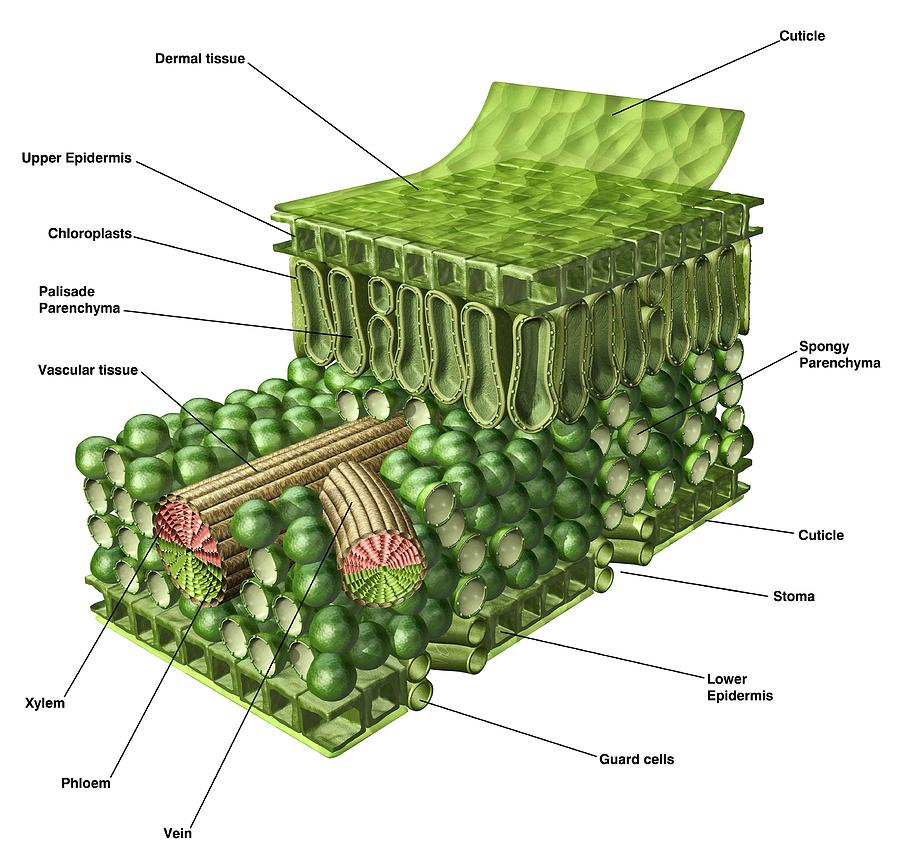leaf structure Labelled diagram
Find these structures on the attached diagram of cellular leaf tissues. Epidermis - The leaf's outer layer and protective "skin" surrounding leaf tissues. Cuticle - A waxy protective.

Ts Of Dicot Leaf Diagram Amyhj
GCSE WJEC Structure of plants - WJEC Leaf structure Plants adapt in order to efficiently collect raw materials required for photosynthesis. These raw materials must be transported through the.

Labeled Diagram Of A Leaf hubpages
Figure 30.8.1 30.8. 1: Parts of a leaf: A leaf may seem simple in appearance, but it is a highly-efficient structure. Petioles, stipules, veins, and a midrib are all essential structures of a leaf. Within each leaf, the vascular tissue forms veins. The arrangement of veins in a leaf is called the venation pattern.

Dicot leaf Biology plants, Plant science, Plant physiology
(i) Auriculate or Semiamplexicaul: In this type of leaf base, the sheathing leaf base only partially encloses the stem (Fig. 4.2 E). (ii) Amplexicaul: This type of leaf base completely encloses the stem, e.g., Sonchus (Fig. 4.2-1) Polygonum etc. 3. Decurrent Leaf Base: ADVERTISEMENTS:
:max_bytes(150000):strip_icc()/parts_of_a_leaf-56abaed23df78cf772b5625a.jpg)
Plant Leaves and Leaf Anatomy
Definition of a Leaf: The leaf is a flattened, lateral outgrowth of the stem in the branch, developing from a node and having a bud in its axil. It is normally green in colour and manufactures food for the whole plant. The leaves take up water and carbon dioxide and convert them into carbohydrates in the presence of sunlight and chlorophyll.

Draw a labelled diagram of the external structure of a leaf. Brainly.in
Lára has a particular interest in the area of infectious disease and epidemiology, and enjoys creating original educational materials that develop confidence and facilitate learning. Download notes on. FREE Biology revision notes on Characteristics. Designed by the teachers at SAVE MY EXAMS for the CIE IGCSE Biology 0610 / 0970 syllabus.

describe the structure of the leaf with the help of a neat well
Leaves are the powerhouse of plants. In most plants, leaves are the major site of food production for the plant. Structures within a leaf convert the energy in sunlight into chemical energy that the plant can use as food.
:max_bytes(150000):strip_icc()/leaf_crossection-57bf24a83df78cc16e1f29fd.jpg)
Plant Leaves and Leaf Anatomy
A Guide to Understand Leaf with Diagram Photosynthesis is the process that generates food for the plant, and leaves play a significant role in the process. They convert photon energy into chemical energy. The structure of the leaf contributes to the process. It also participates in the transportation of water and nutrients.

Anatomy of a Leaf Diagrams 101 Diagrams
How do they work? An microphotograph of a stoma shows the two guard cells which regulate its opening and closure to limit water loss, excrete oxygen, and absorb carbon dioxide. The openings or pores in stomata are formed by two specialized sclerenchymal cells, the guard cells ( Figure above ).

Parts of a Leaf YouTube
Figure 9.3. 2: Cross section of a hydrophytic leaf. Observe a prepared slide of a hydrophyte, such as Nymphaea, commonly called a water lily. Note the thin epidermal layer and the absence of stomata in the lower epidermis. In the spongy mesophyll, there are large pockets where air can be trapped.

Labeled Diagram Of A Leaf
Part of Leaf Diagram | How To Draw labelled Diagram of Leaf easy - Step by Step.This video explains about How to Draw Part of Leaf Diagram in easy steps to r.

Leaf Structure Labeled Best Science Images and diagrams Pinterest
Allow the nail polish about four hours to dry. Using a pair of tweezers, peel off a film (thin skin) from the surface of the leaf. Gently place the film onto a microscope slide and cover with a cover slip. Start with low power and increase to 100x (frequency of stoma can be counted at 100x) Record your observations.

Diagram of a leaf showing typical features of a dicot Flickr
They are attached by a continuous vascular system to the rest of the plant so that free exchange of nutrients, water, and end products of photosynthesis (oxygen and carbohydrates in particular) can be carried to its various parts. Leaves are initiated in the apical bud (growing tip of a stem) along with the tissues of the stem itself.

Label the following diagram of a leaf. Brainly.in
The midrib extends from the petiole to the leaf tip and contains the main vein. Additional veins branch from the midvein. The margin is the edge of the leaf. Figure 3.4.1.2 3.4.1. 2: The petiolate leaves of the geranium consist of a petiole and blade (lamina). The wide lamina is attached to the stalk-like petiole.

Plant Leaf Structure Photograph by Carlos Clarivan Fine Art America
This interactive leaf diagram is perfect for teaching leaf structure. Each of the different parts of a leaf is labelled. Parts included: Show more Related Searches photosynthesis structure of a leaf leaf structure stomata leaf diagram photosynthesis worksheets Ratings & Reviews Curriculum Links Make a Request

Parts of a Leaf, Their Structure and Functions With Diagram Science
The air space found between the spongy parenchyma cells allows gaseous exchange between the leaf and the outside atmosphere through the stomata. In aquatic plants, the intercellular spaces in the spongy parenchyma help the leaf float. Both layers of the mesophyll contain many chloroplasts. Figure 30.10. 1: Mesophyll: (a) (top) The central.